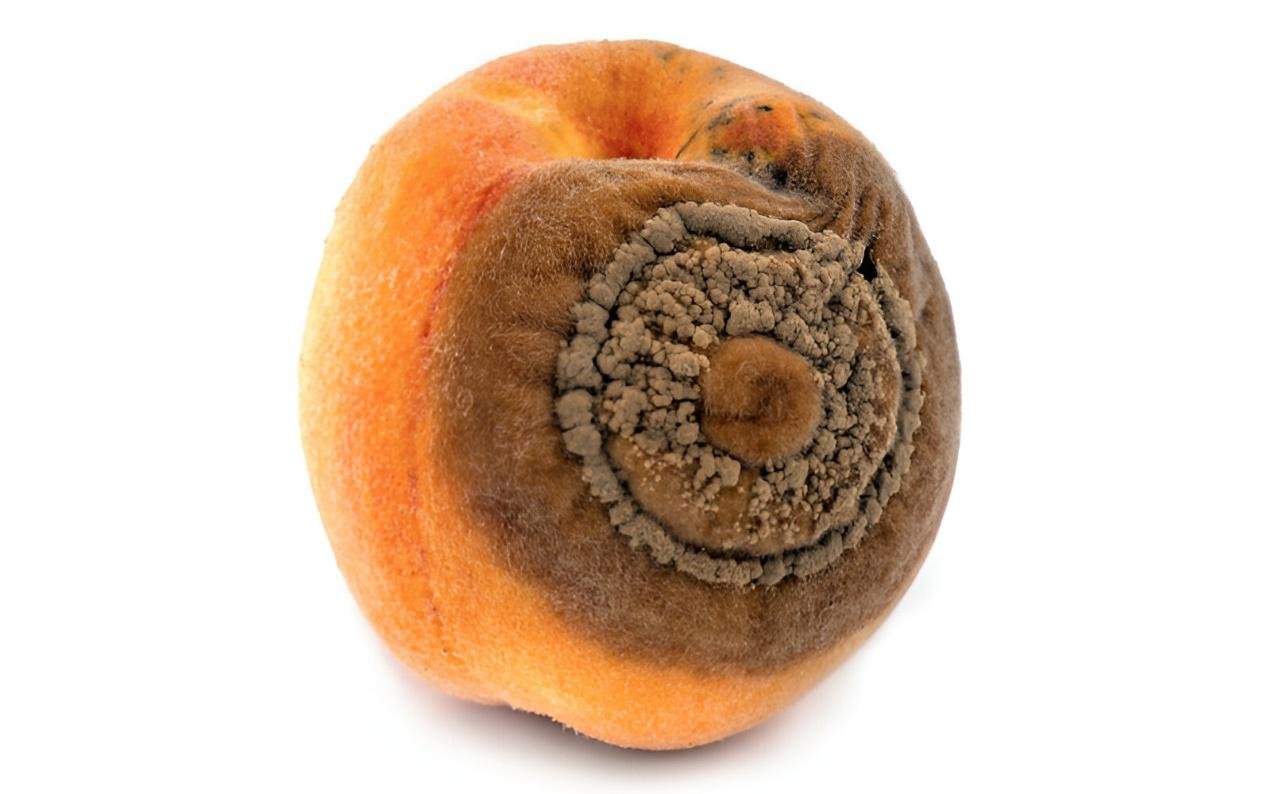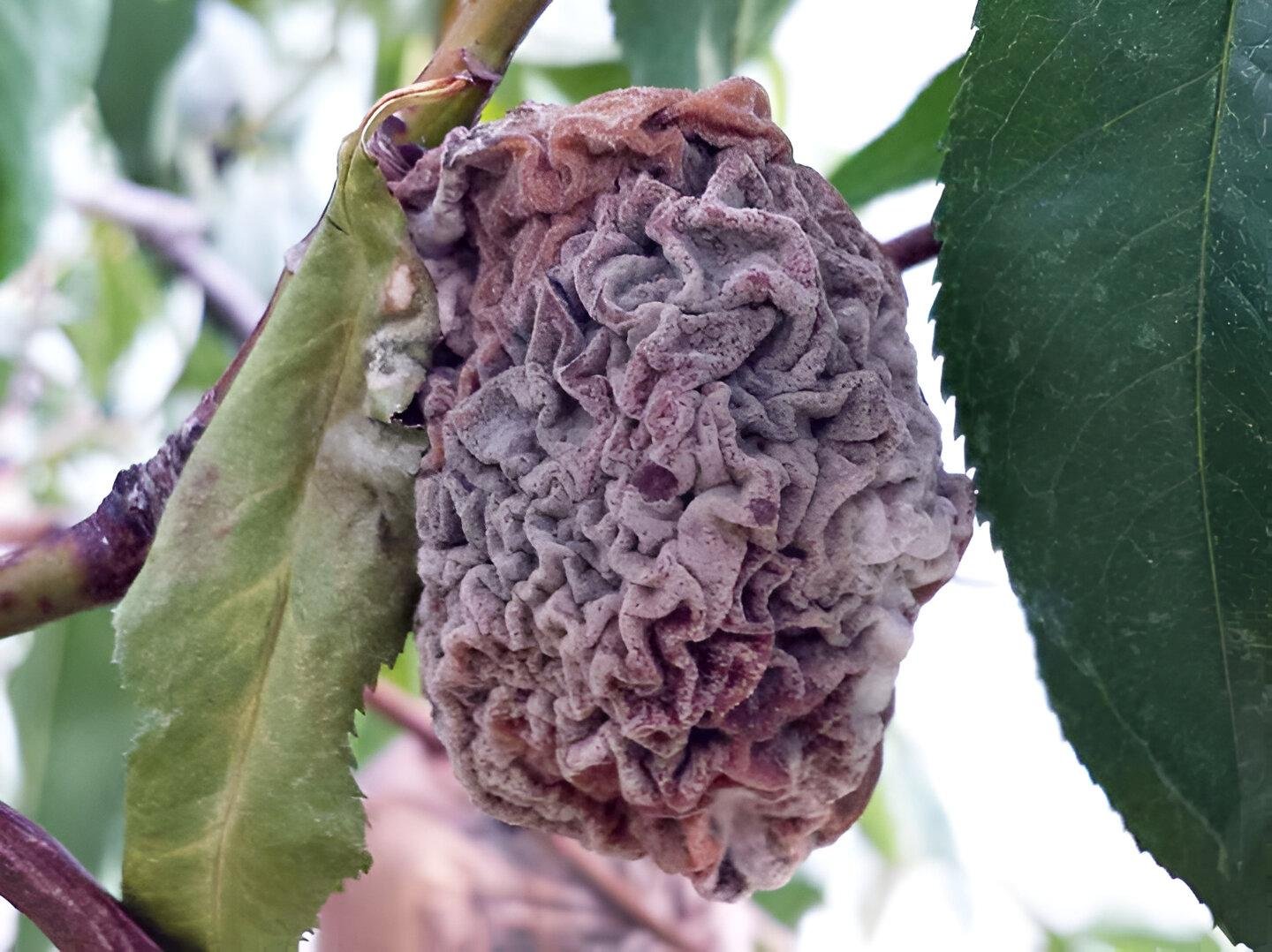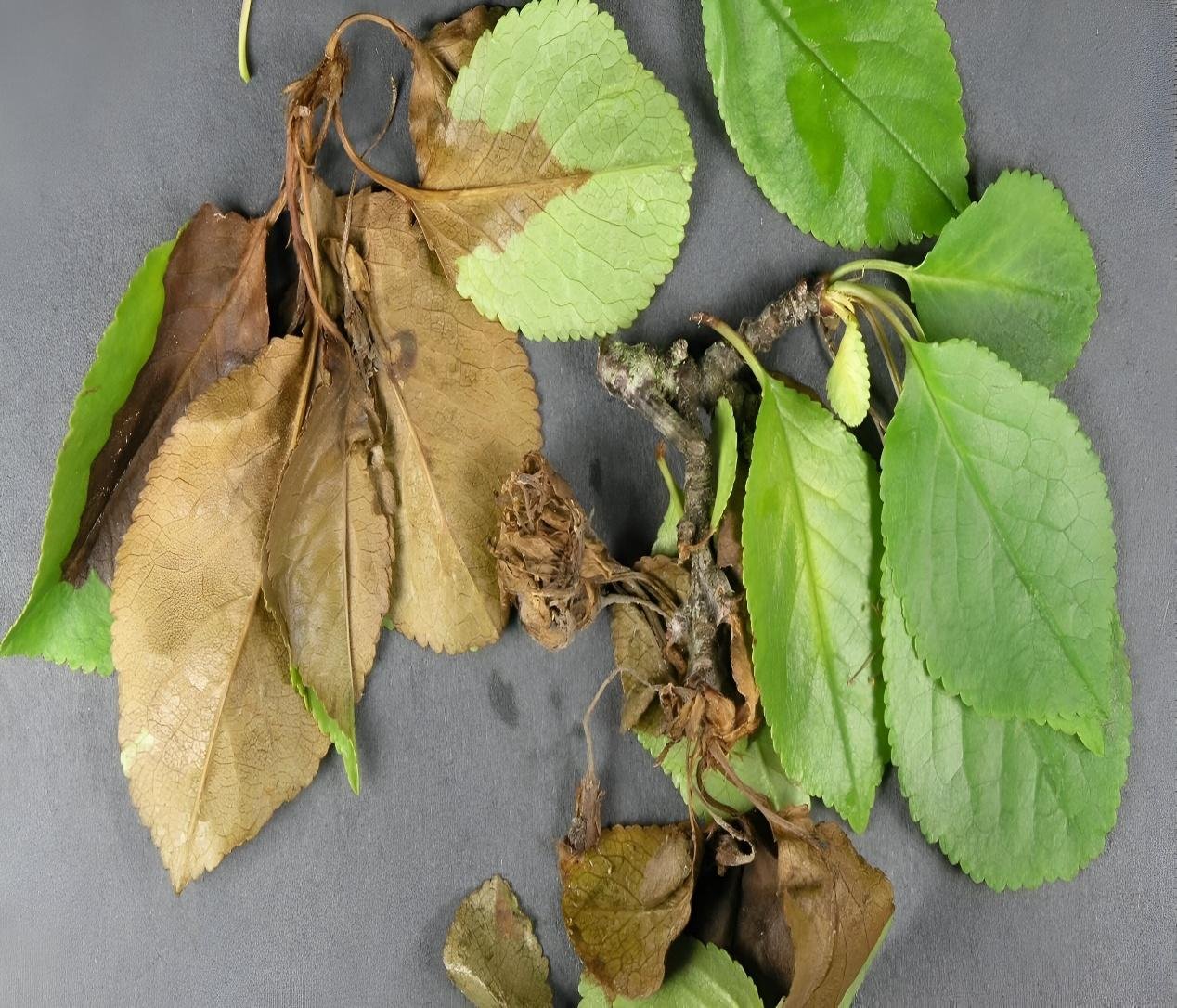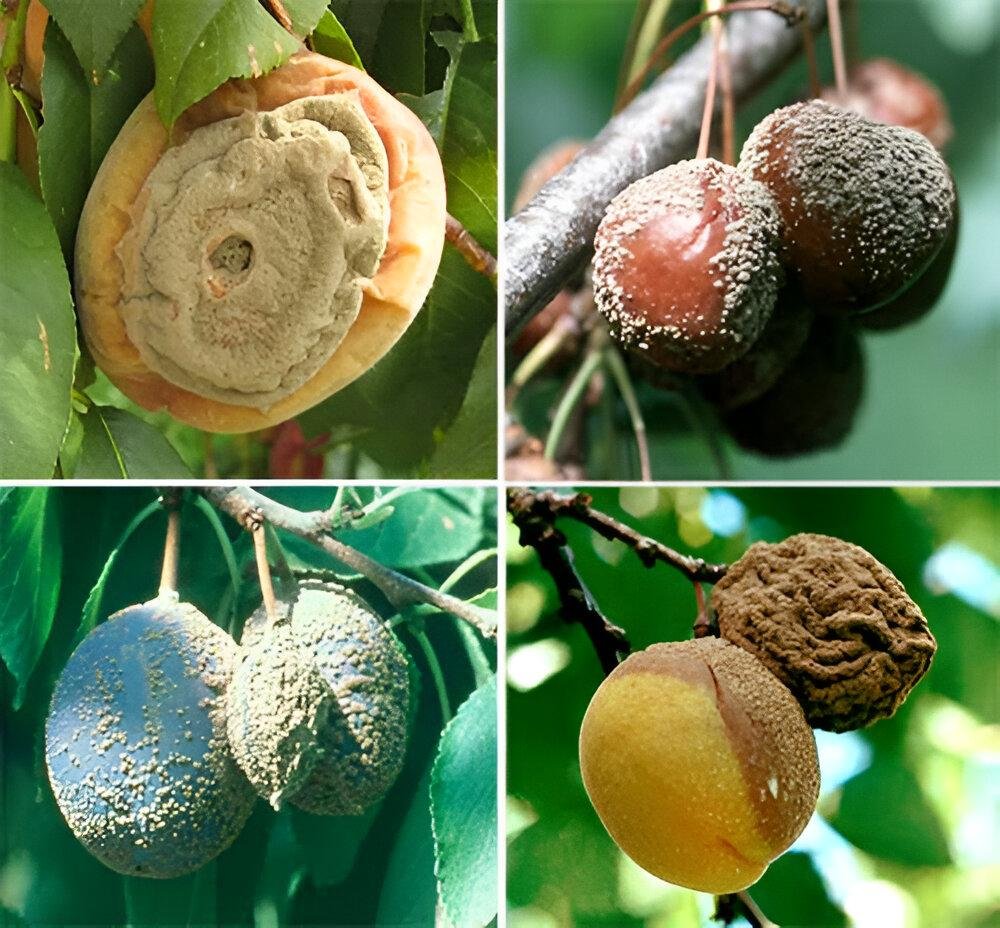Table of contents of the article
ToggleBrown rot is a fungal disease that affects almond fruits, leading to fruit rot and crop damage. This article from the World of Plants website explains how to identify brown mold and ways to combat it.
Symptoms of brown mold
- Scientific name : Brown rot
- The causative fungusThis disease is caused by several types of ascomycete fungi that share a conidial stage, belonging to the genus Monilia
- The first symptoms of the disease appear in the spring in the form of rapid fading and death of the flowers, and their brown color, which later becomes covered with gray spore masses.
- The flowers remain hanging or hanging on their stands if they do not fall due to the wind, and these symptoms are similar to those caused by frost on the flowers. Symptoms resulting from infection with flower inflorescences are called flower blight.

- Infection of flowers or fruits is usually followed by infection of branches, as the fungus moves from the flowers to the fruiting chamber through the flower neck until it reaches the branch that bears it, and attacks the bark, leading to the appearance of sunken, brown ulcers, covered with fungal growths and conidial spores.

- The cankers may completely surround the branch, leading to it withering and dying above the affected area, starting at its top. This resembles dieback, as the leaves on the affected branches become brown in color, and can remain stuck to them for several weeks.
- Trees can often keep the lesion area small, oval in shape around the point where the flower or fruit stand connects with the branch that bears it. This injury is often accompanied by gummy secretions in the affected areas.
- Symptoms appear on the fruits in the form of small, circular, brown spots. Then the infection progresses and extends in all directions, and spore cushions appear on them.
- Finally, the entire fruit becomes rotten, then dries up and turns into mummified things that fall to the ground or remain on trees throughout the winter.

Causes of brown mold
- Mushrooms begin to grow in cool, moist conditions
- During ripening and post-harvest storage, brown rot can spread rapidly from one fruit to another until most of the fruit is inedible.
- The infection is transmitted through wounds.
- The main source of the pest in spring is wilted fruit on trees or on the ground.
- At 70°F, the blossom only needs to be moist for 3 hours for infection to occur.
- At 45°F, the flower must be wet for at least 6 hours for infection to occur.
Suitable conditions for the spread of brown mold
- The disease spreads slowly in early summer. Developing fruits are unlikely to become infected unless they are damaged by insects, hail, or stem rubbing.
- As fruits ripen and change color, they become more susceptible to infection.
- Once one ripe fruit is infected, the infection can spread to neighboring fruit until all fruits in the group are infected
Brown rot development cycle
- The fungus spends the winter in the form of gametophytes in mummified fruits stuck to trees, in ulcers on infected branches, or in the form of false stone bodies in mummified fruits in the soil. In the spring, the mycelium of the fungus, whether in mummified trees or in cankers on branches, produces new conidial spores. While the false stone bodies in the mummified plants buried in the soil give fragrant fruits of the open and petiolate type, brown or red in color.
- Spores can cause infection on flowers, as conidia are carried to parts of the flower by wind, rainwater spray, or by insects. While the ascospores are forcefully ejected from the stalk, forming a spore cloud over the ascomy fruit, and carried by air currents to the flowers.
- The spores germinate and infection occurs within several hours, and new conidial spores are formed, especially with the availability of moisture, on the infected flower parts, causing other infections.
- Then the fungal hyphae spread through the neck of the flower to the fruiting stem until they reach the branch bearing it, where reddish-brown ulcers appear. The ulcer can surround the branch, leading to its drying out and death. The ulcers are covered with conidial fungus spores, which act as a vaccine to subsequently infect the fruits when they begin to ripen, during the humid periods during the summer. Considering that the spores formed on the flowers are short-lived, and the period between flowering and the beginning of the fruit’s ripening is long, these spores do not contribute to causing the infection. On the fruits.
- The germination tubes of conidial spores usually penetrate the fruits through wounds, twig friction, and cold, but penetration may also occur directly through the peel.
- The fungus initially grows between cells and secretes enzymes that decompose and discolor the affected tissue brown.
- The fungus quickly attacks the fruits, and spore cushions form on the surface of the rotten areas, causing the formed conidial spores to cause new infections on the fruits.
Losses of brown rot spread
- The fruit can become completely rotten within a few days, and either fall to the ground or remain stuck on trees.
- Fruits falling on the ground decompose immediately after infection by bacteria and saprophytic fungi.
- The fruits that remain stuck on the trees dry up and turn into mummified plants.
- Transmission of the infection to healthy fruits.


Brown mold control strategy
1. Preventive measures to prevent the occurrence of brown mold
- Brown rot is transmitted through wounds, especially those caused by birds, so use mesh if possible to minimize bird damage
- Cut off all branches affected by cankers and remove all branches that have died due to brown rot in February or March.
- Keep your orchard clean
- Conduct winter plowing on time, which would bury the mummified fruits, leaves, and cut small branches deep into the soil to prevent the fungus from forming the sticky fruits.
- Planting resistant varieties
2. Chemical and organic control recommendations
- Organic control
- Remove all rotten brown fruit and dispose of it immediately. You can bury it at least 30 cm (1 ft) below the surface of the soil.
- Prune and discard infected shoots and blossoms to reduce the amount of fungus available to infect the fruit
- Chemical control:
- Protecting flowers from injury. This can be achieved by using appropriate pesticides two to four times, depending on the prevailing weather conditions, from the stage when the flower buds begin to open until the petals fall. Among the pesticides used for this purpose: Cyprodinil, which is sprayed on the flowers after 30-50% of them have opened.
- To protect ripe fruits from infection, you can start using fungicides such as mancozeb, carbendazim, and trifurin on the trees several weeks before harvesting, and continue spraying every week or two until immediately before harvesting.
In conclusion, we would like to note that we, at the world of plants website, offer you all the necessary services in the world of plants, we provide all farmers and those interested in plants with three main services::-
- Artificial intelligence consulting service to help you identify diseases that affect plants and how to deal with them.
- Blog about plants, plant diseases and care of various crops ... You are currently browsing one of her articles right now.
- An application that provides agricultural consultations to clients, as well as a service for imaging diseases and knowing their treatment for free – Click to download the Android version from Google Play Store، Click to download the IOS version from the Apple App Store.
References
Adobe Acrobat pdf document outlining fungicides available to gardeners)
GOODELL, Barry; QIAN, Yuhui; JELLISON, Jody. Fungal decay of wood: soft rot—brown rot—white rot.
Brown rot – The Royal Horticultural Society
Brown rot of stone fruit – University of Minnesota
Fungal Decay of Wood: Soft Rot—Brown Rot—White Rot – American Chemical Society




